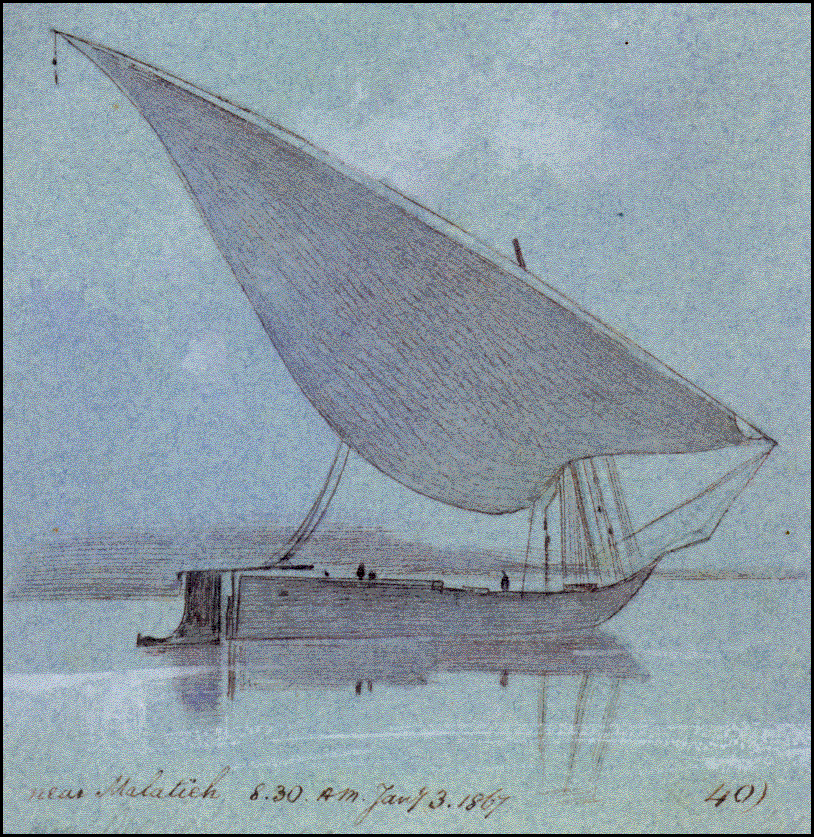
Edward Lear
Egyptian Sketches
Jenny Gaschke
(National Maritime Museum)

Outside of composing an infinite supply of doltish limericks, Edward Lear travelled extensively through the Western world, eventually getting to the Balkans, Greece, the Middle East, Ceylon and India. Although he attended the Royal Academy, most of his art was self-taught.It was during his two trips up the Nile in 1853 and 1866 that he produced the sketches reproduced in this fine volume from the National Maritime Museum. It was the time of the building of the Suez Canal and the inauguration of the overland mail route to India, and Lear traveled there with some of the Victorian stars, artists like Thomas Seddon, W. H. Hunt, and the somewhat mysterious writer and glum pornographer, Sir Richard Burton.
Lear's journals from this period are overly detailed, if not tedious: "The boats of the Nile are the djerm (germ), the maádil, aggub (akkub), mash or ráhleh, dahabéëh, cangia..." etc. And his verses from this period are almost as dumb as his limericks. This from the Pelican Chorus:
We live on the Nile. The Nile we love.
By night we sleep on the cliffs above;
By day we fish, and at eve we stand
On long bare islands of yellow sand...
Wing to wing we dance around, ---
Stamping our feet with a flumpy sound,
Opening our mouths as Pelicans ought,
And this is the song we nightly snort:---
Ploffskin, Pluffskin, Pelican jee,
We think no Birds so happy as we!"Ploffskin, Pluffskin, Pelican jee!" Sheesh!
Despite all this minestrone, there are a few verses we cannot help but still love. For instance, there's this merry song from "The Owl and the Pussycat:"They dined on mince, and slices of quince,
Which they ate with a runcible spoon,
And hand in hand, on the edge of the sand,
They danced by the light of the moon,
The moon,
The moon,
They danced by the light of the moon.Lear's drawings here are pencil and ink with a wash of watercolor. Most are like Japanese sumi-e: quick, small, efficient. They are also artful, atmospheric and exquisitely exotic. It was the Egyptian sails that struck him, and they are all here, in all varieties of angles and colors and detail.
They become at one with the background temples and palms and excavations, the sun and the stars and the moon the moon. The riverboats at Gau el Kabir are crammed with goods, sacking, and people alike; faces are repeated from time to time as if to get them right.
The dahahbéën at Esneh is isolated, stark, and austere. A drawing from Massaba with three boats is enlivened by tiny representations of dromedaries floating in the air above them.
One picture from Manfaloot from 1867 is a gorgeous evocation of twin double sails that dominate the boat and the helmsmen alike in a purple cast that is truly breathtaking.The editor calls it "poetical topography." But it is more than that: it is the perfect marriage of form, function and love of light and color.
§ § § Despite his vulgar poetics --- vulgar not as prurient, but vulgar as in simple-minded --- Lear was an interesting character. He was one of twenty-one children. Like Dosteyevsky, he was an epileptic of the gran mal persuasion, and like most epileptics haloes and auroras warned him before an attack so he could go into hiding. It was the shame of seizures --- in those days, said to be of "demonic possession" --- that possibly made him a cynic and a recluse.
During his Egyptian journeys he found himself in that peculiar travel state where one is forced by language to be with around those who speak one's own tongue, unable to converse with those who don't. What he wrote in his lifetime, especially his letters from his various journeys, seems mostly artless. His power flowed from his ability with his pen: not in words, but in his faultless linear ability, a rare ability to suggest form, filled with the flowing lines of the great river (and the great culture) that lay all about him when he was so far from home.
We will not bother to reproduce his doggerel verse, but will admit to the reader that of all the limericks --- not Lear's --- that we have heard in our lifetime, only two remain with us still to entertain us at this late stage of life. Persons easily offended by vulgarity are advised to not read past
HERE I. There once was a man from St. P.
Who got stung on the arm by a wasp.
When asked if it hurt,
He said that it didn't,
But he sure was glad it wasn't a hornet.II. There was a man from Boston,
Who had a little Austin;
There was room for his ass
And a gallon of gas:
But his balls hung out and got all tangled around the axle and ultimately he lost 'em.--- Carlos Amantea